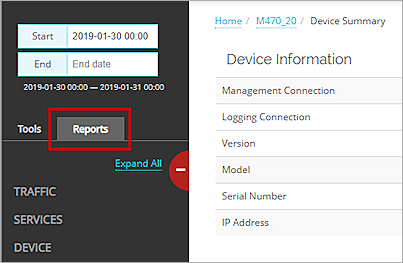Applies To: Cloud-managed Fireboxes, Locally-managed Fireboxes
The PCI report includes several predefined reports that provide information to help you make sure that your network complies with the Payment Card Industry Data Security Standard (PCI DSS).
This report is available when log messages with data for this report exist in the specified time frame. To make sure that your Firebox sends log messages required to generate this report, follow the steps to Enable Logging for this Report.
How to Use this Report
Use this report to assess your compliance with PCI standards. For more information, see About PCI Compliance Reports.
View the Report
This report is available in WatchGuard Cloud and in Dimension.
- Log in to WatchGuard Cloud.
- Select Monitor > Devices.
- Select a folder or a specific device.
- To select the report date range, click
 .
.
- From the list of reports, select Compliance > PCI.
The report opens.
- To see reports for your Fireboxes or FireClusters, select Home > Devices.
The Devices list opens.
To see reports for your groups of Fireboxes, select Home > Groups.
The Groups list opens. - Select the Name of a Firebox, cluster, or group.
The Tools > Executive Dashboard page opens. - Select the Reports tab.

- Select Compliance > PCI.
The report opens.
Included Reports
The PCI report includes several predefined reports that provide information to help you make sure that your network is compliant with PCI standards.
The PCI report includes these reports:
| Report Name | Description |
|---|---|
| Zero-Day Malware (APT) |
Detailed report of all the threats identified by APT Blocker as Zero-Day Malware (not identified until after the traffic passed through the firewall) that are relevant to PCI. Each threat includes the time, threat level, threat ID, content name, source and destination IP addresses, the policy and protocol, the host, the sender and recipient addresses, and the number of attempts. |
| Advanced Malware (APT) |
Detailed report of all the threats identified by APT Blocker that are relevant to PCI. Each threat includes the time, threat level, threat ID, content name, source and destination IP addresses, the policy and protocol, the host, the sender and recipient addresses, and the number of attempts. |
| Virus (GAV) | Detailed report of the Gateway AntiVirus actions that are relevant to PCI. |
| Intrusions (IPS) | Detailed report of all Intrusion Prevention Service actions that are relevant to PCI. |
| Audit Trail |
Detailed report of all audited configuration changes for a device that are relevant to PCI. Includes the user account that made the change, the change that was made, the date and time of the change, and any comments that were added about the changes. |
| Alarms | Summary report of alarm records on the device that are relevant to PCI. |
| Authentication |
Detailed list of users who failed authentication to the device that are relevant to PCI. Includes the date, time, and reason for authentication failure. |
Enable Logging for this Report
This report includes several reports. To collect the data required for this report you must enable logging for reports in your Firebox configuration. For more information, see Where to Enable Logging for Reports.
Logging for cloud-managed Fireboxes is automatically enabled. For locally-managed Fireboxes, you must manually enable logging in Fireware Web UI or Policy Manager. For more information, see Set Logging and Notification Preferences.